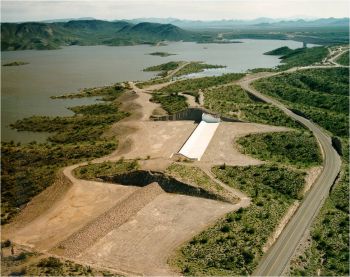Fuseplug Spillways

|
| Fuse plug spillway, New Waddell Dam, Arizona.
(Image Source: U.S. Bureau of Reclamation) |
“These types of control structures are associated with staged releases and suited for auxiliary and emergency spillways. A fuseplug control structure may include one or multiple bays containing the fuseplug embankments. The zoned embankments will be placed to a specified height and include a pilot channel through each embankment crest set to a specified elevation associated with a given flood event. The pilot channel(s) and the number of fuseplug embankments are set to limit the discharge for given ranges of reservoir water surfaces. Fuseplug spillways should only operate during remote flood events, where more frequent flood events are accommodated by reservoir flood surcharge and discharge from service spillways and/or outlet works. An important consideration is the very large discharge capacity associated with operation from a small increase in reservoir water surface. The large amount of flow that could be released from an operating fuseplug must be carefully evaluated in terms of downstream impacts. Other considerations include evaluating and mitigating erosion potential both upstream (due to reservoir wave actions) and downstream of the fuseplug that could lead to headcutting and undermining the fuseplug control structure. Also, careful and thorough design and construction of the embankments are needed to ensure proper operation of the fuseplug spillway. Additionally, note that once a fuseplug spillway operates, the reservoir cannot be maintained above the control structure crest (base of the control structure containing the fuseplug embankments). This could result in the loss of reservoir storage until the fuseplug embankment(s) has been reconstructed. Finally, this type of spillway is applicable to concrete, embankment, and composite dams”.[1]
Citations:
Revision ID: 7444
Revision Date: 07/25/2023
